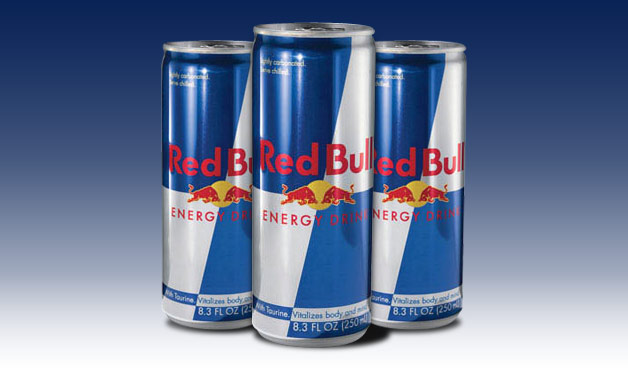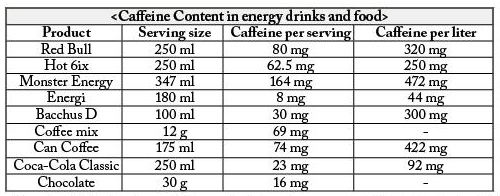Will Red Bull give you wings forever?
 | ||
It now appears that gulping down energy drinks is one growing trend during the examination period in universities. Looking around the campus, abandoned cans of energy drinks are easily found and it is not to strange to see that many students have a can of energy drink on the desk while studying in the library. When faced-- with many assignments, some students tend to look for an energy drink first. A salesclerk of school cafeteria Sangrokwon said, “Over 500 energy drinks sold out in a day. Students, these days, really like this kind of beverages.” She added that she saw one student buy 10 cans of energy drinks and consume several cans on the spot.
“I regularly drink energy drinks during the examination period. For university students, energy drinks like “Red Bull” or “Hot 6ix” are necessary beverages before taking a pop quiz or tests.” A college student added that “The beverages make you feel that you can expand the time that you can use efficiently, and that you won’t be distracted.” The atmosphere of fellow students toward energy drink is explosive.
Energy drinks are typically attractive to university students. In the examination period, these beverages are all sold out in school cafeterias, convenience stores and vending machine. Students use energy drinks to stay awake longer to study, write papers or prepare for exams. They recommend the drink to other colleague students, spreading stories that they help you stay awake and concentrate longer. Mixed energy drinks are also wildly popular among young students. At the festival, youngsters combine alcohol and energy drinks. Alcoholic energy drinks like Vodka Red Bull, Jager bomb and Agwa bomb are famous. The name ‘Bomb’ means the drinker will feel more stimulated and less fatigued. These alcoholic energy drinks are easily found at cocktail bars near the campus.
Beverage companies know that young people are excited about these products. The marketing of energy drinks mostly targets at the young people in their twenties, especially university students. As a result, companies place their ads on SNS, UCC and web sites. They penetrate into the campus and give out the product at free. The slogans of their marketing also make it easy to convince you of what they want to say. They encourage the consumer to try their energy drink - ‘Red Bull gives you wings (Red Bull)’, ‘Unleash the beast (Monster Energy).’ In fact, Korea energy drink market had grown to nearly 20 billion won in sales.
It is true that energy drinks increase your energy release and alertness in mental performance. Professional athletes drink energy drink before the game begins as they improve alertness and endurance. Researchers suggested that the components of energy drink are the reason for the effects of increasing mood and performance. Energy drinks generally contain caffeine, guarana, citric acid, sugar, vitamins B, and herbs. Some drinks contain high level of sugar, and citric acid that reducing fatigue and absorbing water immediately. Blending balance of ingredient may be different by brands. However, a common ingredient in most energy drinks is caffeine - caffeine is often in form of guarana or marked as natural caffeine.
A problem is that energy drink contains larger amount of caffeine than many expect. One can of energy drink (250 ml) contains 60-80 ml, about three times the amount of caffeine as cola. Kim Hee-sub, a researcher at Dongguk University’s Department of Food Engineering, said, “Energy drinks contain more caffeine than a strong cup of coffee. Drinking 2-3 energy drinks at one time may induce anxiety, irritability and insomnia.” He added, “Energy drinks can help you stay up at night. But relying on the drink can harm your health and leave you feeling fatigued later.”
Over-caffeinated drinks are regarded as ‘unsafe food and additives’ in the U.S. and Canada. It has been reported that energy drinks have been linked with nausea and irregular heat rhythms. There are movements to ban energy drinks from schools in England and France. They argue that the government should take measures against over-caffeinated drinks.
The Korea Food & Drug Administration (KFD) also suggests that an average adult should take less than 400 mg for one day. However, one cannot figure out how much caffeine is contained in drink products which are sold in retail shops. The problem driven by overconsumption of caffeine has led the KFD to require manufacturers todisplay caffeine amounts on every single drink product. By 2013, KFD expects that customer can check the content of every drink product.
Health experts also see problems with mixed alcohol and energy drinks. “Red Bull” is often used in alcoholic beverages such as Vodka Red Bull, Jager bomb and Agwa bomb. Experts warn that this caffeinated alcohol can be hazardous as they stimulate the alcohol intake, resulting in impairments of the nervous system. When caffeine is combined with other ingredients (especially when mixed with another beverage or alcohol), it can have critical side effects in the long term, health experts advise. Health experts also warn that mixed drinks with caffeine and alcohol cause dehydration.
The most important thing is that customers should know the health effects of over-caffeinated drinks. Taking several energy drinks at once can leave you with health problems.
 | ||
| ▲ Here’s a table indicating caffeine content of major energy drinks in a typical retail fridge. The amount of caffeine contained in energy drinks doubles that of Bacchus D. | ||
The table shows the caffeine content in energy drinks. There are major energy drinks in a typical retail fridge. Popular brands such as Red Bull and Hot 6ix contain much more caffeine than 1 cup of coffee and cola. The most noticeable thing is that we can take in caffeine from many diverse products - by green tea, chocolate and cola etc. From the table of caffeine content in food and drugs, you can figure out how much you intake caffeine in a day. By being aware of the amount of caffeine in your drinking, you can adjust your caffeine intakes in a day and be a rational customer.
“Will Red Bull gives you wings?” My answer is this: Red Bull does not give you wings forever. If what the ad implies were true, I’d most certainly have wings by now.

